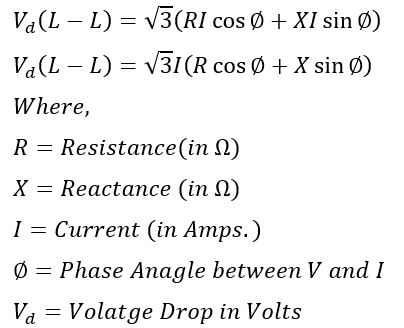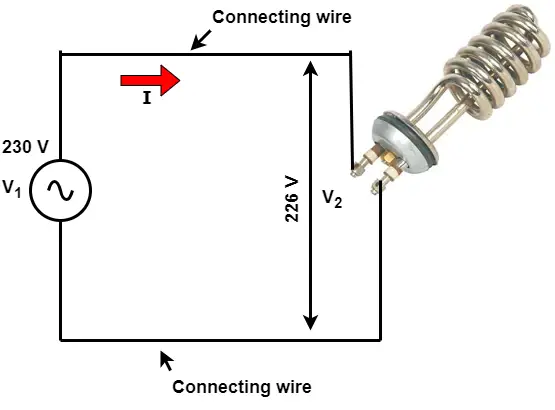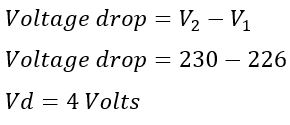Voltage drop is the amount of voltage reduction that occurs in all components of the circuit caused by impedance when current flows through it. Therefore, the voltage at the receiving end of the circuit is always less than the voltage at the sending end of the voltage source. The voltage difference between both ends is called voltage drop (VD) or potential drop (PD).
In an electrical system, different losses may occur to decrease the overall output and efficiency of that system. This article describes the effects of voltage drop (VD) in an electrical system.
What is a Voltage Drop?
Voltage drop (VD) is the decrement in the electrical potential within a circuit or a conductor due to the resistance offered by the current passing through that circuit or conductor.
Electrical current faces resistance in its pathway and increases the potential drop in the form of heat. This process is undesirable as this causes a loss of energy across sources of energy, conductors, and contacts.
VD varies proportionally in load with the useful load power that must be converted into other useful energy. You can understand the concept from this example, one circuit (it may be a heater) has a resistance of 20 ohms but the conductor/wire that supplies the circuit’s current has 0.4 ohms resistance. It implies that there will be about 4% loss in the supply voltage because of connecting wires.
In different countries, there is a different maximum limit of voltage drop (VD) in electrical loads to enhance and maintain the efficiency of an electrical system.
Causes of Voltage Drop
Voltage drop occurs due to different factors that contribute to the voltage loss in an electrical circuit. One of the main reasons for dropping voltage is the resistance or impedance of a conductor. The resistance restricts the flow of electrical current by offering hindrance in its way. Here the energy dissipates in heat form that eventually, drops the potential in a circuit.
Here are some more factors that cause voltage drop:
- Current Magnitude: If the amount of current increases in a circuit, it will increase the VD in that circuit. This is given by Ohm’s law formula, i.e. V = IR.
- Material of Conductor: Different materials have different resistivity that affect the resistance in that material. Higher resistivity means higher resistance and eventually it will have a large VD.
- Temperature: Materials with a positive temperature coefficient have more voltage drop due to the higher temperature of the material
By understanding the causes of potential drops, individuals should design/select the appropriate circuit or material that can offer less VD.
Elements Responsible for Voltage Drop
There are different elements that cause a potential drop in a circuit. The resistor is a passive element that primarily introduced resistance in a circuit. The followings are the elements responsible for potential drop(PD).
- Resistor (DC Circuit)
- Capacitor (AC Circuit)
- Inductor (AC Circuit)
The current faces opposition while passing through a conductor. Ohm’s law and Kirchhoff’s law state to provide the amount of voltage reduction. According to Kirchhoff’s law, the reduction in voltage across all components is equal to the supply voltage. The voltage drop will appear in the form of heat.
Similarly, in the case of an AC circuit, current face reactance (another type of current opposing parameter). The combination of reactance and resistance is called impedance (Z). For AC current circuit, Ohm’s law becomes as,

Where V is the VD, I is the circuit current, and Z is the impedance of the AC circuit.
The energy is dissipated in the form of heat caused by VD in the source’s internal resistance, across contacts, conductors, and components.
Voltage Drop Formula
DC Circuit

The VD in a circuit can be calculated using Ohm’s law. The formula for calculating the voltage drop in a DC circuit is;

Where,
I – Current flowing in the circuit
R= Resistance of the circuit
According to this formula, the VD is directly proportional to the current passing through a resistor and its resistance.
AC Circuit
To calculate voltage drop in an AC circuit, we can use the following formula,

Where,
I – Current flowing in the circuit
Z= Impedance of the circuit
The power factor of the AC circuit plays a very important role in voltage drop in the AC circuit. The poor power factor causes more voltage drop in the circuit because it causes an increase in line current.
The voltage drop (Line to neutral) in the AC circuit is;

The voltage drop formula (Line-Line) in an AC circuit is given by;
Significance of Voltage Drop
Electrical systems face opposition in the current flowing passage due to resistance. Significance of voltage drop lies in its effects on the performance, efficiency, and safety of electrical components and systems.
The following factors should be considered.
- Power Loss: Potential drop causes loss in power of a system. Energy will be converted into waste in the form of heat. It can lead to the use of more conductors to compensate for the voltage drop. This can also cause cost increases.
- Design of Electrical System: VD must be considered to design electrical circuits, equipment, or panels. The conductor and wire must be selected to minimize the voltage drop.
- Performance: Excessive potential drop may cause the poor performance of equipment.
Voltage Drop Calculations
The following steps can be taken to measure the potential drop in the circuit.
- Measure the source voltage. Let it be V1
- Measure the voltage across the load. Let it be V2.
- Find the difference between V1 and V2.
- The difference between V1 and V2 is the voltage drop in the circuit.
VD in the above example is;

Thus, the voltage drop in the connecting wires is 4 Volts.
How to Reduce Voltage Drop?
The potential drop in the circuit depends on the current and the resistance of the circuit. It is possible to reduce the VD by either decreasing the circuit resistance or by decreasing the load current. The load current of the equipment is fixed and in this case, the voltage drop can be reduced by reducing the circuit resistance. The following steps can be taken to reduce the potential drop in the circuit.
- By selecting the Thicker Wires- The resistance of the wire is inversely proportional to the cross-section area. If you select a thicker wire, the resistance of the wire will be less and it leads to lower circuit resistance. This approach of reducing VD is suitable for AC and DC circuits.
- By Improving the Power Factor of AC Circuit- The line current increase if the power factor of the load is low. The reactive current drawn by the load causes more voltage drop because of increased line current. Installing a capacitor bank across the load can improve the power factor. The capacitive reactive current drawn by the capacitor nullifies the inductive reactive current and eventually, the line current reduces, resulting in the reduction in voltage drop.
Conclusion
Electrical systems face potential drop due to opposition faced in the flow of current. This behavior decreases the system’s efficiency. VD occurs due to resistance in a circuit or conductor. The potential drop can be more or less depending on the resistivity and type of material of a conductor. We should select materials that offer less voltage drop to achieve maximum efficiency it.
Numerical Examples
Numerical Example (1): Consider a 10 ohms resistor in a circuit and 2 amperes current is flowing through it. Calculate VD across the resistor.
Solution:
Given, R = 10 ohms, I = 3A
Using the voltage drop formula,

Numerical Example (2): Consider a 100-meter-long copper wire with a cross-sectional area of 2 square millimeters. If 5 amperes of current passes through it, calculate its potential drop. Use resistivity of 1.68 x 10-8 ohm-meter for copper.
Solution:
Give data is,
Length (L) = 100 meters
Cross-sectional area (A) = 2 square millimeters
= 2 x 10-6 square meters
Current (I) = 5 amperes
Resistivity (ρ) = 1.68 x 10-8 ohm-meter
In order to calculate the resistance (R), we use the formula
Putting the values, we get,
Now using the voltage drop formula,
